Table of Contents

Guitar cables are essential components for your guitar. It is important to invest in a high-quality guitar cable failing which can ruin your stage performance or the gig you have been eyeing for a long time.
These guitar cables can offer a noticeable difference in guitar sound signals reducing the crackles and buzzing, a common problem in faulty or low-quality guitar cables.
Playing interesting genres like rock, heavy metal, or jazz can be fun with the best guitar cable which makes sure your guitar sounds would stop midway and kill your vibe.
Plug in with confidence and rule the show with the best guitar cables. Your jamming sessions should involve practicing and not trying to re-adjust the jack now and then.
Your favorite songs like The Blackbird by The Beatles or Hotel California by the Eagles will sound great when played without any signal interruptions, just pure tunes giving the most immersive experience. Thus, it becomes essential to invest in good quality guitar cable.
However, while it may not be the most interesting part of your guitar component, you must give enough attention to it when uninterrupted guitar playing without any intermittent signal stops is what you are looking for.
Guitar cables come in different sizes at different price points and to make an informed selection you should go through a lot of factors beforehand.
This post includes some of the most important aspects that you should look for along with a handpicked list of the best guitar cables which you can go through and make an informed buying decision.
The 8 Best Guitar Cables For Electric, Acoustic and Bass Guitar
-
D'Addario Accessories Guitar Cable
Product Dimensions: 8 x 0.08 x 12 inches.
Positive: Provide Superior Conductivity, Durable Construction, Feature Geo-tip Design.
Negative: Some Connectivity Issues.
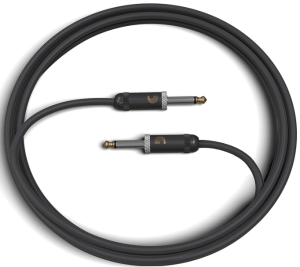 D’Addario Accessories Guitar Cable has a Geo-tip design that ensures a secure connection in any instrument, pedal, or amp jack so you won’t lose a beat during performances or recordings.
D’Addario Accessories Guitar Cable has a Geo-tip design that ensures a secure connection in any instrument, pedal, or amp jack so you won’t lose a beat during performances or recordings.
Plus, the in-line solder joints provide superior conductivity and strength, ensuring you get the best sound possible. Best of all, the cable reproduces the natural tones of your instrument with zero interference, making it the perfect addition to any musician’s setup.
Customer Review For D'Addario Accessories Guitar Cable

-
KLIQ Guitar Instrument Cable
Package Dimensions: 9.29 x 6.61 x 1.61 inches.
Positive: Flexible Construction, Gold Plated Connectors, Triple Shielding Coverage.
Negative: Very Lightweight.
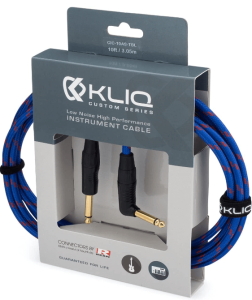 The KLIQ Guitar Instrument Cable features a 24AWG oxygen-free pure copper core. This low-capacitance cable ensures that every note is carried with the utmost clarity and accuracy. Its high-density OFC 99% braided shield helps to reject any handling noise and interference, allowing you to focus on the music.
The KLIQ Guitar Instrument Cable features a 24AWG oxygen-free pure copper core. This low-capacitance cable ensures that every note is carried with the utmost clarity and accuracy. Its high-density OFC 99% braided shield helps to reject any handling noise and interference, allowing you to focus on the music.
With a powerful chuck-type strain relief and a rugged tweed outer jacket, it can withstand considerable abuse without succumbing to the wear and tear of everyday use. Its professional connectors and 24k gold-plated plugs also increase conductivity and tarnish resistance. With its multiple layers of shielding and insulation, you can rest assured that this cable will provide maximum noise isolation and unparalleled performance.
Customer Review For KLIQ Guitar Instrument Cable

-
Fender California Series Instrument Cable
Package Dimensions: 11.42 x 7.48 x 3.54 inches.
Positive: Provide Life Time Guarantee, Stylish Color, OFC Copper Construction.
Negative: Quality Could Be Better.
 The Fender California Series Instrument Cable is the perfect choice for musicians who demand high performance from their equipment. It is designed with a braided shield with OFC copper that delivers superior sound quality and frequency balance.
The Fender California Series Instrument Cable is the perfect choice for musicians who demand high performance from their equipment. It is designed with a braided shield with OFC copper that delivers superior sound quality and frequency balance.
This cable is guaranteed a lifetime, meaning you can depend on it for all your performances. In addition, its beautiful lake-placid blue color makes it a stylish addition to any stage setup. So whether you’re a professional musician or just starting, it is the ultimate choice for uncompromising sound quality and reliability.
Customer Review For Fender California Series Instrument Cable

-
Hosa GTR-210 Guitar Cable
Product Dimensions: 8 x 1 x 7 inches.
Positive: Include OFC Conductor, Hi-density Shield, Feature All-metal Plugs.
Negative: Not Suitable For Daily Use.
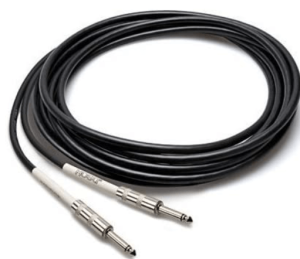 The Hosa GTR-210 Guitar Cable has all-metal plugs for touring and other high-stakes situations. The durability makes this cable stand out. The Oxygen-Free Copper conductor ensures that your signal will remain clear and strong.
The Hosa GTR-210 Guitar Cable has all-metal plugs for touring and other high-stakes situations. The durability makes this cable stand out. The Oxygen-Free Copper conductor ensures that your signal will remain clear and strong.
At the same time, the Hi-density OFC braided shield protects against unwanted interference from EMI and RFI.
Customer Review For Hosa GTR-210 Guitar Cable
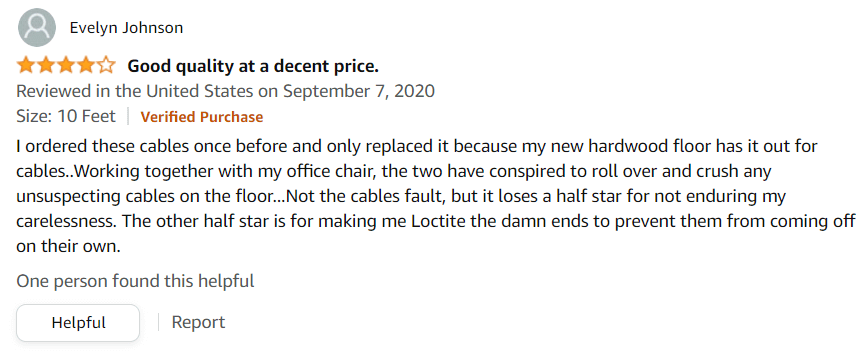
-
Elebase TRS Instrument Cable
Product Dimensions: 8 x 1 x 7 inches.
Positive: User-friendly Design, Deliver High-fidelity Performance, Available In Multi-colors.
Negative: Build Quality Is Questionable.
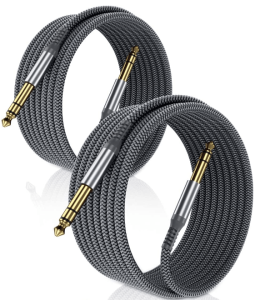 Elebase TRS Instrument Cable is the ideal tool for all your music needs. With a premium copper conductor, two-layer shielding, and TRS gold-plated connectors, this cable works to minimize signal interference and deliver exceptional sound quality.
Elebase TRS Instrument Cable is the ideal tool for all your music needs. With a premium copper conductor, two-layer shielding, and TRS gold-plated connectors, this cable works to minimize signal interference and deliver exceptional sound quality.
In addition, this cable is practically unbreakable thanks to its incredibly sturdy aluminum exterior and top-notch nylon braiding, designed to take on the strain of daily use. Plus, with a handy Velcro strap to keep it organized and a 12-month warranty for peace of mind, you’ll be investing in a product that’s both reliable and stylish.
Customer Review For Elebase TRS Instrument Cable

-
New Bee Guitar Cable
Product Dimensions: 4 x 4 x 0.1 inches.
Positive: Wide Compatible, Easy To Disassemble, PVC Insulation Material.
Negative: Breaks Easily.
 The New Bee Guitar Cable is a must-have for any musician seeking top-notch sound and reliability. With 22AWG oxygen-free copper center conductors, this cable enhances signal transfer.
The New Bee Guitar Cable is a must-have for any musician seeking top-notch sound and reliability. With 22AWG oxygen-free copper center conductors, this cable enhances signal transfer.
The PVC insulation material and high-density stranded copper double shield also contribute to exceptional noise rejection for quiet operation. In addition, the right-angle metal connectors make for a secure and versatile connection to any instrument or electronic equipment.
Customer Review For New Bee Guitar Cable

-
GLS Audio Instrument Cable
Product Dimensions: 7.68 x 7.48 x 1.93 inches.
Positive: Feature Double Insulator Shields, Prevent From Twists & Tangles, Durable Construction.
Negative: Cuts Out Issues.
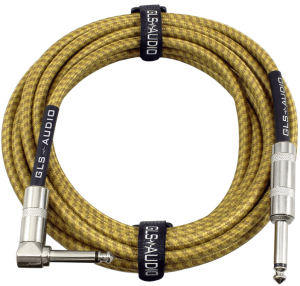 The GLS Audio Instrument Cable is designed with high-quality oxygen-free copper, adding just the right amount of resistance and conductivity for an electric guitar. This cable apart is its ability to coil neatly, preventing any twists and tangles.
The GLS Audio Instrument Cable is designed with high-quality oxygen-free copper, adding just the right amount of resistance and conductivity for an electric guitar. This cable apart is its ability to coil neatly, preventing any twists and tangles.
With double insulator shields, the line ensures maximum isolation. In contrast, the low capacitance of the TS cable enhances the overall sound quality. The flexible tweed cloth jacket provides durability and an extra layer of added style.
Customer Review For GLS Audio Instrument Cable

-
Sovvid Guitar Cable
Product Dimensions: 7.52 x 7.44 x 0.63 inches.
Positive: Strong Compatibility, Offer Life Time Warranty, Very Durable.
Negative: It Doesn’t Last Long.
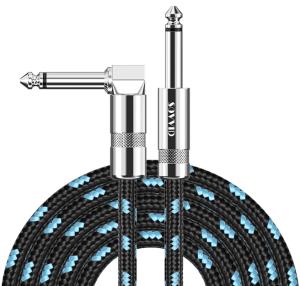 The Sovvid Guitar Cable has a high-density OFC 95% braided shield and top-quality TPE material insulation, providing excellent noise rejection and anti-interference capabilities.
The Sovvid Guitar Cable has a high-density OFC 95% braided shield and top-quality TPE material insulation, providing excellent noise rejection and anti-interference capabilities.
In addition, it features multiple shielding layers and insulation to minimize hum and ensure stable performance with pure sound. Its braid nylon jacket also boasts impressive tensile strength and abrasion resistance, ensuring that it will hold up to frequent use. Plus, the anti-oxidant, nickel-plated plug offers excellent conductivity for peak performance.
Customer Review For Sovvid Guitar Cable

What To Know When Looking For The Best Guitar Cable?
-
Cable Capacitance
Cable capacitance is defined as the capacity to store charge by two conductors that are separated by an insulating material. It is measured in pico farads per meter or foot, (pF/m or pF/ft). Being cumulative, the capacitance increase with an increase in the length of the cable. Thus, the longer the cable, the higher will be capacitance. The chances for a high-frequency roll-off of highs can be experienced. For instance, a cable measuring 50pF/m which is 4 meters in length will give a cable capacitance to hold a charge of 200pF/m.
This cable capacitance may or may not be good for your tonal pickups, it’s just how it would interact with the entire rig that matters. It can tone down highs providing warmth in the mid-range. Similarly, passive tonal pickups can sound muddy, a high capacitance cable with a buffer pedal can help polish it. A low cable capacitance can allow for a more natural “presence” or “brightness” to reach the amplifier. This can reduce the harshness of treble at high ends by reducing hiss and other noises.
For instance, KLIQ Guitar Instrument Cable comes with a high-density OFC 99% braided shield with a low capacitance to manage pickup of your exclusive tones that reject interference and noise falling in the guitar sound signal. It has a 24AWG oxygen-free pure copper core, that works to deliver high-fidelity guitar tones.
Long guitar gig? Fret not, the zinc diecast shell ensures a stable connection with their 24-carat gold-plated plugs that are robust and can withstand corrosion or tarnishing. Talk about their build and we like their tough construction that is meant for long guitar sessions on stage and gives a signal connection offering nothing but pure audio clarity for recording. In addition to this, the KLIQ Guitar Instrument Cable has immaculate shielding and insulation for utmost noise isolation it can provide you with the utmost flexibility with no issue of being tangled in the rig. You can easily coil them up for storage after your show without worrying about ruining their quality.
Another good option is the GLS Audio Instrument Cable. Get stage ready with these robust and dual-insulating shield cables. They offer an impressive low capacitance. With this, you can experience enhanced noise control while recording a cleaner sound. Their nylon braided design is such that they can keep sound interference to a minimum. They are ideal for electric guitars and come with an angled and straight plug, so these cables never fall in your way while you are performing on or off stage.
-
Shielding Quality
The shielding present in these guitar cables surrounds the insulator. It is required to implement the return signal in order to establish an efficient signal connection between the guitar and the amplifier. Thus, it protects guitar signals from experiencing any sound interruptions that can happen from surrounding noises, radio frequencies, or electromagnetic induction.
Thus, look for a guitar cable that has premium shielding quality, like the Fender California Series Instrument Cable, which comes with a braided sheer with an OFC copper that balances out the frequencies and delivers premium audio quality. This can let you experience an uninterrupted guitar session with its robust build to avoid any twisting, bending, or kinking.
-
Plug Durability
Plugs face the most wear and tear and intense pressure on and off stage. Their constant plugging and unplugging require durable quality plugs. In addition to this, they should be robots enough to withstand the sudden pressure which may occur when you accidentally put your foot on them. A good option can be the Hosa GTR-210 Guitar Cable is made using metal and can let you take them along on your touring excursions or live events. Their sturdy build can let you play for extended hours without ruining their quality. They can provide you with clearer guitar signal quality, thanks to their oxygen-free conductors.
Meanwhile, the Sovvid Guitar Cable comes with a 1/4-inch straight and right-angle nickel-plated plug that gives a good amount of conductivity. In addition to this, they offer a no-delay audio transmission and make you experience the best possible signal quality without suffering from any audio loss. What we liked about these guitar cables is their noise rejection features, thanks to their multiple layering of insulation and shielding that reduces electric signal sound while giving you premium audio quality.
What Are The Parts Of A Guitar Cable?
-
Insulation Material
The dielectric insulator is present around the center conductor made using a thermoplastic. It works by separating this conductor from the shield and providing it insulation, It can affect your guitar’s tone quality while ensuring the flexibility quotient of your guitar cable.
-
Center Conductor
The center conductor is made using copper due to its conducting capability. It helps in delivering a reliable and clearer guitar tone to the amplifier. Other materials used as center conductors materials can include silver, gold, and platinum.
-
Shield
A shielding covers the insulator and plays an important role in signal completion that starts from the guitar and is carried to the amplifier. Guitar cables have shielding to protect the signal from facing unwanted signals like humming, and radio signals in the pathway which can ruin its quality.
Are Guitar Cable Balanced?
Guitar cables are unbalanced and can be subjected to surrounding noises and microphonic noises. These cables are quarter-inch cables with a shield and wire. This shield is connected to the plug sleeves while the wire here is attached to the tip. Guitar leads send audio signals through the length of the cable while picking up unnecessary noises and humming. Thus, guitars require unbalanced guitar cables for guitar amplifiers that require a Tip and Sleeve or TS connector to work. These unbalanced cables work by carrying weak signals to the amplifier to enhance the audio audible enough for human ears.
Thus, unbalanced cables connect the guitar to the amplifier but it should be noted that these cables can pick up unwanted signals. Thus, considering a length of around 15-20 ft maximum should be good enough to experience clear guitar audio signals.
Signs That Your Guitar Cable Is Of Poor Quality
You cannot escape the horror that a bad-quality guitar cable can cause you when you performing on the stage. Thus, you should check for the signs and when it’s time to change your guitar cable. They start producing quieter sounds or can stop abruptly at random intervals. Additionally, they create a buzzing sound when you try to move the cable cord across, or even a slight movement causes excessive crackles and hums. Thus, look for these signs to know if the guitar cable is faulty or is made of sub-par quality.
- Weak Guitar tones: With a faulty guitar cable, you may fail to experience accurate sound quality. This happens when the cable cannot transmit sound signals to the connected amplifier.
- Causing Cracking And Humming: Faulty cable connectors cause humming and cracking when you try to move the cable or touch its end.
- Intermittent Cutting Of Sounds: Faulty or loose audio jacks can cause unintentional cutting off of sounds that disturb the guitar play. Replace these connectors or invest in a high-quality guitar cable.
- No Sound Upon Plugging-in: A faulty guitar cable or a problem with the amplifier can cause this issue. Try switching to a new cable but if the problem still persists and you hear no sound, you should get your amplifier checked.
- Catching Environment Noise: Unbalanced guitar cables fails to cancel out noises like microphones and pickup environment noises. These cables are prone to capture radio frequencies or Electromagnetic signals that ruin guitar sounds. A braided shield guitar cable can limit this occurrence.
- Bent Nose Or Loose Cable Jack: A loose cable jack can interrupt a guitar’s audio signal to reach the amplifier that ruins the guitar’s tone. You can try tightening or replacing it when you experience a poor-quality signal transfer.
Tips To Maintain Guitar Cable
- Coil Them Properly
- Avoid Stepping On Them
- Avoid them from being trapped around the pedalboard and AMP
Conclusion
While you would mistake them for being just some tool for your guitar, a high-quality guitar cable can evidently make a huge difference in the guitar’s signal quality. I hope this post has covered all of your questions and helped in clearing any doubts that you faced when your mind was tossing over the ultimate decision to buy guitar cables.
Guitar cables are game-changers for your entire instrument setup. Their quality is of the essence where capacitance and impedance can play a major role. The best guitar cables will enhance your guitar-playing sessions and will give you uninterrupted audio signals without any disturbance from the surroundings.
Frequently Asked Questions/FAQs
Guitar cables do not positively affect sound quality. However, they affect guitar tone by subtracting certain frequencies. Additionally, a poor-quality guitar cable can pick up radio frequencies and cause crackles and pop. A faulty or broken cable when plugged in, fails to produce any sound at all.
Gold-plated material for guitar cables is more durable and robust which can add to their life years as they do not corrode or oxidize.
Guitar cables are made using copper wires that are wrapped inside a dielectric insulator with a plastic covering. They are required to carry the guitar sound signals to speakers and amplifiers.
The jack present at the end of the cable lets you connect the guitar to other audio devices. These jacks come in varied sizes with small microphones, LINE Out or LINE In small audio devices, a 3.5mm mono being the preferred choice for guitarists.